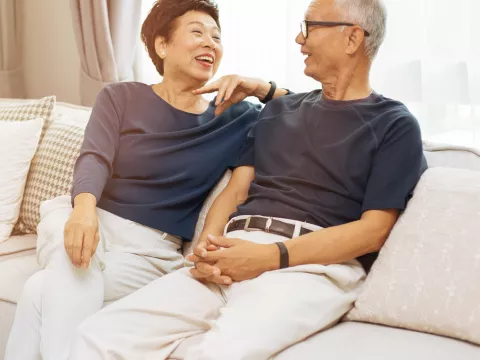- AdventHealth

You may not realize it, but the cells of your bones are in a constant state of renewal. As you age, it’s common to have some changes in this process that affect your bone density or strength.
For women especially, low bone density often goes hand-in-hand with changes in your hormone levels during menopause.
Understanding bone loss and how it develops over time can help you keep the condition from progressing — and literally reverse the signs of aging.
What’s the Difference Between Osteopenia and Osteoporosis?
The two conditions linked to low bone mineral density are osteopenia and osteoporosis. When bone loss occurs, it follows stages; you start at normal bone density, progress to osteopenia in the middle stage and then later to osteoporosis.
Osteopenia
Osteopenia is the first stage of bone loss and is often referred to a “silent” disease since most people with the condition experience no symptoms at all.
It typically affects people over age 50, and genetics and ethnicity also play a part (Caucasian and Asian women have a higher risk).
Women are at a higher risk for two reasons; they usually start with a lower bone density in the first place, and then as menopause occurs, the lack of estrogen affects how bone tissue is renewed.
Additional risk factors for osteopenia include:
- A diet low in calcium and vitamin D
- Certain medical conditions, such as rheumatoid arthritis, lupus, and celiac disease
- Certain medications, such as steroids or anti-seizure drugs
- Lack of weight-bearing exercise, such as walking or running
- Overuse of alcohol
- Tobacco use
The good news is that if you have osteopenia, making simple lifestyle changes — like eating a balanced diet, staying active and taking supplements — can help prevent further bone loss:
Osteoporosis
A common condition that affects over 50 percent of people living in the U.S. age 50 and older, osteoporosis (low bone mineral density) is the last stage of bone loss and the more severe of the two conditions. It happens when your body doesn’t make enough new bone tissue, or your body loses bone tissue.
When your bones become less dense, problems can arise, such as:
- Bone pain
- Fractured or broken bones
- Loss of height or tendency to hunch over
Risk factors for osteoporosis are similar to those of osteopenia. If you already have a diagnosis of osteopenia, you’re at a much higher risk for developing osteoporosis.
If you suspect you have osteoporosis, screening is as simple as a painless test at your doctor’s office. DEXA scans measure the mineral content of your bone. The results, called T-scores indicate if you have normal bone density, osteopenia or osteoporosis.
Treatment for Osteoporosis
Treatment for osteoporosis includes continuing the same active steps you’d take when you’re first diagnosed with osteopenia. But since your bone loss has further progressed, you may also need to take medicines that help you strengthen your bones. For women, this may also include hormone replacement therapy.
And since you’re vulnerable to fractures, it’s also critical for you take steps to minimize your risk of falling. These include:
- Doing exercises to help with balance
- Improving lighting in your home and using night lights
- Placing grab bars in the bathroom and a slip-resistant mat in the shower
- Removing area rugs
- Wearing your glasses and having your vision checked often
Share Your Bone Health Concerns With Your Doctor
Understanding these two conditions, and what you can do to prevent your osteopenia from progressing to osteoporosis, already places you on the path to keeping your bones healthy. Take the next step by being an active partner in your health. Ask questions when you’re concerned and work closely with your doctor on any changes you experience as you age.
Learn more about the comprehensive orthopedic care at AdventHealth.



